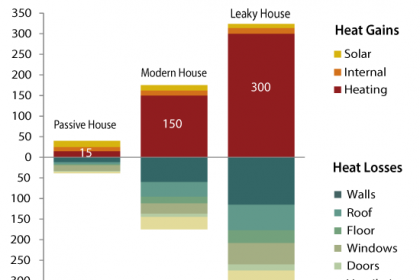
Insulated House Benefit.
In the image above, we depict the heat gains and losses for a ‘leaky house’, a ‘modern house’, and a ‘passive house’. While it is tempting to look at heat gains first, it is actually the losses that explain what is going on.
The leaky house has solid walls, poor loft insulation, an uninsulated floor, single glazed windows, and lots of draughts. Because of this, it needs 300 kilowatt-hours of heating for each square meter of space per year (kWh/m2a) just to stay warm.
The modern house has insulation in the wall cavity and loft, an insulated floor, double glazing, and some draught excluders. Because of its better insulation, it needs just half the heating of the leaky house, 150 kWh/m2a, to maintain a similar internal temperature.
The passive house has superb insulation in all materials, triple-glazed windows that face the equator to maximize solar gains, and is so air tight that it uses a ventilation system to keep the air fresh. It needs just 15 kWh/m2a of heating, some of which comes from heat recovery in the ventilation system.
What does this mean in simple terms? The leaky home’s heating bill might be $1,500 a year, $750 for the modern, and $100 for the passive house.
What Does this Mean?
Although this looks simple on paper, really good insulation is actually rocket science. And annoyingly for most of us, investing in good insulation makes most sense when a home is originally built. Cost-effective retrofits take real talent.
That said, if you own your own home, many types of insulation are a good investment. The colder your climate and the higher your fuel costs, the better the paybacks are.
As a general rule, you want to investigate the cheapest ways to improve your building’s envelope first. This will probably start with caulking and draught proofing. Loft or attic insulation might be next. Then wall cavity insulation if you have one. Floor covering and curtains may be old school, but can be really worth it if you’re on a budget or renting.
For major expenses like upgrading windows and external wall insulation, the payback can be glacial, so you should really do your research and also factor in value changes to your home.
